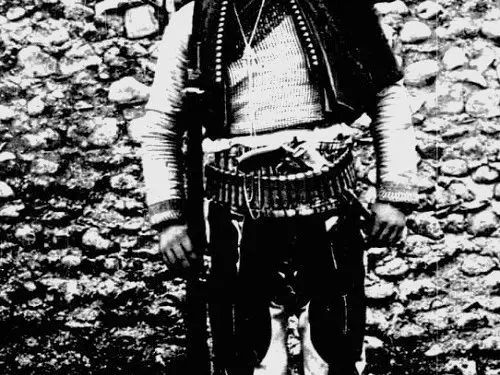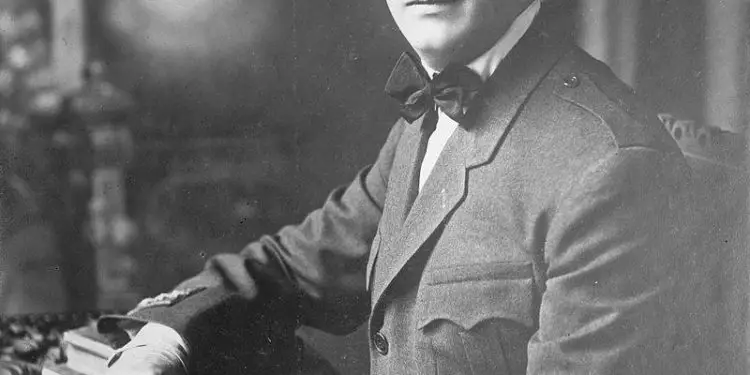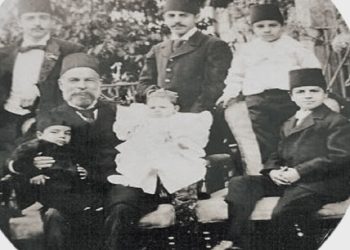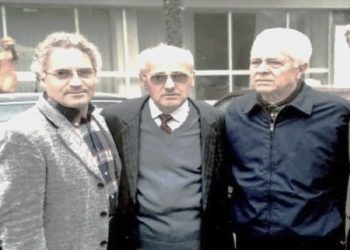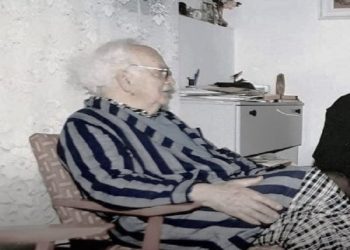Unbiasedness, Correctness, and Great Sympathy for the Albanian People
Memorie.al / The unbiasedness, correctness, and great sympathy for the Albanian people, his close ties with Albania, and the scientific acceptance and argumentation of the thesis of the direct origin of Albanians from the Illyrians, as well as their autochthony in Albanian lands, were the reasons that led Belgrade to organize the assassination of Milan Šufflay. Immediately after the assassination, the police confiscated all the manuscripts in his apartment. A good part of these manuscripts seems to have been lost forever, as to this day, no trace of them can be found.
The echo of the murder was huge. “Tribuna,” Rome; “Berliner Tagblatt”; “New York Times”; “Frankfurter Zeitung”; “Arbënia,” Tirana; “Vullneti i Popullit,” Tirana, etc., all reacted with their writings. Science and literature giants also reacted with a special memorandum: Albert Einstein, Heinrich Mann, Dr. Josef Bajza, Dr. Max Hildebert Boehm, Dr. Karl Fritzler, Dr. Zenon Kuziela, Dr. Martin Spahn, Dr. Branimir Jelić, Josip Milković, Lumo Skendo, Faik Konica, as well as the “Ligue Internationale des Droits des L’Homme” and the “Fédération Universitaire Internationale.”
We encounter Šufflay’s interest in Albanians and Albania at the beginning of his scientific career when, while researching and collecting documents in the archives of Dalmatia for Tadija Smičiklas’s “Codex diplomaticus,” he discovered very interesting, unpublished source materials belonging to the Albanian Middle Ages. This period, at the time, was completely unexplored and aroused extraordinary interest in the young researcher, an interest that preoccupied him so much that it became the main goal of his scientific activity for his entire life. Throughout this period, from the pen of Dr. Milan Šufflay, came extraordinary studies of high scientific value in the field of albanology.
Such is the monumental work “Acta et diplomata res Albaniae mediae aetatis illustrantia,” which he published together with L. Thallóczy and K. Jireček. Dr. Šufflay organized the collected material and accompanied it with various comments, so that most of these comments represent discussions of high scientific value and can be used as separate studies. He continued the work on the preparation of the publication of this masterpiece even further. A part of the documents from various archives were described, the relevant literature was consulted, and a concrete plan for the publication of the third volume was made.
The Discovery of the Third Volume: A Scientific and Cultural Sensation
The discovery of the regesta of the third volume of “Acta Albaniae…” in the Central State Archives of Tirana is a real scientific and cultural sensation. Recently, in the periodical press, as well as in specific studies in Croatia, Albania, Kosovo, Greece, Austria, Italy, and elsewhere, it has been written that the third volume, which was ready for publication, has been found. In fact, the truth is quite different. Dr. Milan Šufflay had not managed to prepare the third volume for publication, as has been written and claimed until now.
In his manuscripts, which are preserved in the Croatian State Archives in Zagreb, some of these documents, which make up two-thirds of the third volume, are scattered in various boxes. This is all that has been discovered after the research carried out, not the complete manuscript of the third volume, as is now claimed. So Dr. Milan Šufflay had neither written nor prepared the third volume for publication.
The above claims were confirmed when, in the Central State Archives of Tirana, in the fund of the Ministry of Education (fund 295, file 85, pp. 1-43, year 1931), the complete content of the much-talked-about third volume of “Acta et diplomata res Albaniae mediae aetatis illustrantia” was discovered, which also caused numerous debates and controversies among researchers, historians, and journalists.
Šufflay had prepared, as in the two previous volumes already published, the “regesta” [synopsis] of the documents that were to be included in the third volume. Šufflay had obtained the information about the existence of these documents from various publications of source corpora by authors such as Baronius, Cerone, Eubel, Farlati, Fermendin, Gelcich, Hopf, Iorga, Ljubic, Makuev, Marinesco, Pastor, Thallóczy, Theiner, and Waddingo, which he had managed to consult during the preparation of the first two volumes of AA. From these publications, he had collected not only the data on the content of the documents but also on their location.
He grouped the notes on the documents according to the archives and libraries where they were located, such as in the Archives of Venice (450 documents from 1407-1451), the Vatican Archives (113 documents from 1405-1451), the Archives of Naples (20 documents from 1402-1451), the Archives of Barcelona (12 documents from 1447-1451), the Archives of Ancona (8 from 1412-1439), the Museo Civico of Venice (2 from 1420), etc.
It is interesting that in the content of the third volume, M. Šufflay had not included the documents from the Archives of Barcelona, which some Spanish scribes had described for him, but he had lent them to the Serbian academic in Belgrade, Jovan Radonić, for consultation for a study. The latter published them in 1942, after M. Šufflay’s death, without his permission. M. Šufflay had insistently asked Radonić to return the documents from the Barcelona archives, and yet he had kept them, even though he had promised Šufflay he would return them.
Newest Discoveries from the Dubrovnik State Archives
Šufflay had also failed to include some documents from the Archives of Dubrovnik and Kotor. He himself confirmed this in a letter discovered some time ago in the Dubrovnik Archives. In the letter, dated January 9, 1931, he asks to be allowed to study the documents preserved in this archive, as he was preparing to publish the third volume of “Acta et diplomata res Albaniae mediae aetatis illustrantia.” On this occasion, from Šufflay’s own hand, we have a very important piece of information that the third volume was being prepared, that it was never written.
In addition to this letter, in the Dubrovnik Archives, we have also discovered the minutes made by the archive about the study that Milan Šufflay did there until February 17, that is, one day before he was killed. These minutes are of primary importance, as all the volumes, documents, and manuscripts that Šufflay used during his study are accurately and pedantically noted there. This is an extraordinary convenience for us, to be able to reconstruct everything that Šufflay studied and described for the third volume of his masterpiece, especially since we had no information until now about what Šufflay planned to include in the third volume from this archive.
Following Šufflay’s notes, we consulted some of the volumes, manuscripts, and documents that were noted by the archive’s supervisors, and thus we accurately confirmed that the archival material studied by Šufflay did not exceed the year 1451, which was the final limit for the third volume. On this occasion, we thank Prof. Ivo Orešković, Dr. Ivo Veselić, Nikša Selami, and Ivana Lazarević, who enabled us to see and compare the archival material and also provided us with all the documentation for Šufflay, which was only for internal service.
Šufflay Presents Albanian Culture at a High Level of Development in the Middle Ages
After special studies and analyses, made after the research and discovery of the archival material, Šufflay presents Albanian culture at a high level of development in the Middle Ages, defending the theory that this culture was closer to the Byzantines and Dalmatians than to the Slavs settled in the Balkans and that it had a rich tradition from ancient times. His contribution in this regard is well-argued and has strong scientific foundations.
Dr. Šufflay’s contribution to the treatment of the issue of the rise of Albanian dynasties in Northern Albania and the problem of their genesis breaks it down in such a way that, by finding various blood or marital relationships with neighboring Montenegrin, Croatian, Greek, Macedonian, Bulgarian, or Serbian nobles, he notices a certain influence on the organization of the Albanian state structure and other institutions that had a long tradition in these lands.
In addition to this, he also deals with the problem of the institution of the notary, which he analyzes from its beginnings in the Albanian coastal cities, drawing a parallel between the development of this institution in northern Italy and Dalmatia on the one hand and in southern Italy and Albanian lands on the other, a study that has so far remained the only one in this field.
By analyzing the political and territorial-geographical units, according to archival source data, Dr. Šufflay examines the problem of intertwining Western and Eastern elements in the topographical nomenclature of Albania, thus overcoming the outdated and one-sided so-called “scientific” theses on the exclusive influence of the West or the East in the Balkan region, thus arriving at a new scientific conclusion, according to which in this geographical area we are dealing with intertwined influences without any favored distinction in favor of one or the other influence.
Šufflay proves the Illyrian origin of the Albanian language and Albanians with scientific arguments, among others, with the presence of names of places, regions, and brotherhoods, which he treats as Illyrian names, and which can be broken down with the linguistic dough of Albanian. On the other hand, he expresses the opinion that Albanian is an idiom of Illyrian and a new phase of an ancient Illyrian dialect, because Albanians live where the Illyrians lived in ancient times and were in these lands, without any doubt, before the invasion of the Slavs.
In Dr. Milan Šufflay’s other studies, the great wealth of factual source material is also noticeable, but the economic and social factors and their influence have somehow been left aside without being properly analyzed and examined. For him, the history of Albanians is mainly the history of a distinct ethnocultural entity, with ancient autochthonous roots and uninterrupted continuity, with an extraordinary regenerative ability, which represents the authentic essence of the history of the Balkans in general, and that of Albania in particular.
Milan Šufflay’s Stay in Albania and the Agreement for the Continuation of Studies in the Field of Albanology with the King and the Albanian Government
The Albanian government, showing special respect and honor for the world-famous Croatian scientist and albanologist, invited him at the end of 1930 to visit Albania. This invitation came immediately after the “Kaiserliche Akademie der Wissenschaften in Wien” had proposed to Dr. Šufflay to continue the publication of the third volume of “Acta et diplomata res Albaniae mediae aetatis illustrantia.”
Received with the highest state honors, from King Zog, the Prime Minister, the Minister of Culture, and finally by the members of the Albanian parliament, Dr. Milan Šufflay’s efforts in scientific research in the field of albanology and especially in the study and publication of medieval documents, which until then were almost completely unknown, were recognized and, in a way, rewarded.
Accompanied by Albanian intellectuals and politicians, the great Croatian researcher visited various church archives, libraries, archaeological sites, and got to know the Albanian culture and tradition, about which he had written so much.
Impressed by the numerous medieval inscriptions and documents, he asked for most of them to be photographed or described. Thus, later, when he returned to Zagreb, he would study them thoroughly and draw important scientific conclusions. Unfortunately, he never managed to do such a thing, because he was killed by the criminal hand of the Serbian police.
On the evening of February 18, 1931, around 8:00 p.m., on “Dalmatinska” street no. 6 (in Zagreb), Dr. Milan Šufflay was mortally wounded from an ambush. The wounds were serious, and he died the next day, on February 19. The killers were Branko Zwerger, Ljubomir Beloševeć, and Stevo Večerina, who had received orders from Belgrade to liquidate Dr. Šufflay.
The Albanian State Covers All the Expenses for the Publications of “Acta Albaniae…” and a multi-volume History of Albania
During his stay in Albania, on January 16, 1931, Dr. Šufflay gave a speech in the Albanian parliament, where he elaborated in detail on the work regarding the publication of the continuing volumes of “Acta Albaniae” as well as the “History of Albania.” For this, the Albanian parliament, from the state budget, ordered the Minister of Education to pay a sum of 75,000 gold francs to “Banque Commerciale de Bâle à Zurich,” to the account of Dr. Milan Šufflay, which today is equal to about 4 million dollars.
The method of scientific examination, the impartiality, correctness, pedantry, the multiple analyses and studies, be they paleographic, diplomatic, onomastic, toponymic, or others, are unsurpassed even to this day. His broad culture, knowledge of many languages, will, and perseverance, which always made the truth triumph, even in cases when someone did not like it, enabled him to do so.
Although it has been written that Dr. Milan Šufflay did not write much, the truth is quite different. His works and studies are scattered in newspapers and magazines of the time, but even those published as separate books are known only to a small number of specialists and researchers, while the general public is unaware that they exist.
The Hungarian National Library of Budapest, “Széchényi,” Preserves a Correspondence of Milan Šufflay with Ludevit Thallóczy and Jozef Bajza
In the Hungarian National Library of Budapest, “Széchényi,” a correspondence of Milan Šufflay with Dr. Ludevit Thallóczy and Jozef Bajza has been discovered, with a volume of 219 unpublished and unknown letters [or 462 pages] that deal with the Albanian medieval problem; various publications, as well as the continuation of the study and research in various archives of Europe.
The correspondence is in Hungarian, written by Šufflay himself, mostly by hand, while a small number of pages are typed. This correspondence covers the period from 1908-1915. The special feature of this correspondence is that it very openly reflects Milan Šufflay’s long-term goals and plans for fundamental studies in the field of albanology, including the preparation of an 8-volume history of Albania, from antiquity to the declaration of independence in 1912. / Memorie.al




